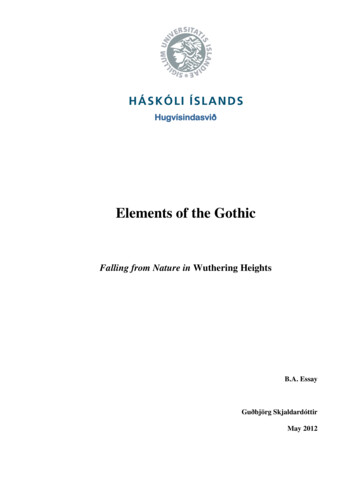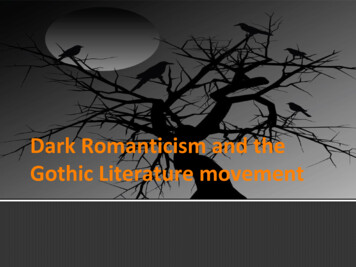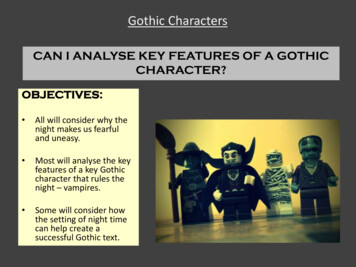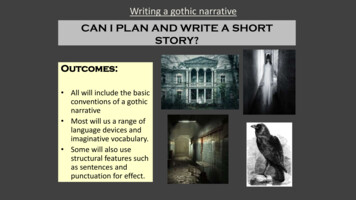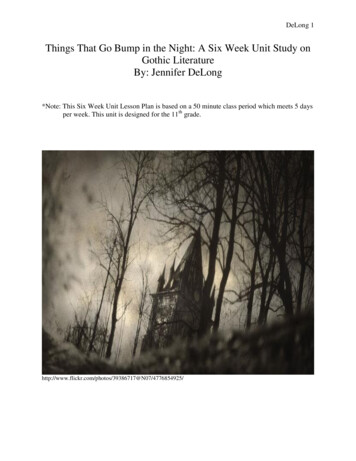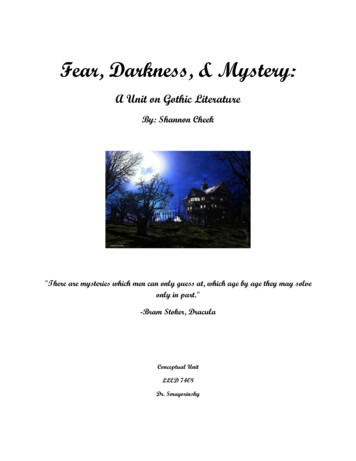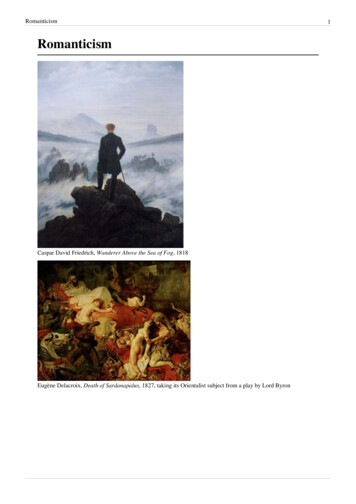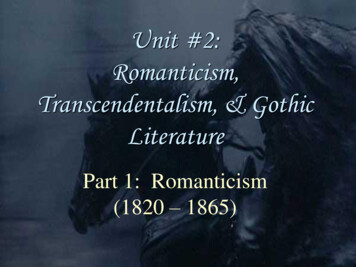
Transcription
Unit #2:Romanticism,Transcendentalism, & GothicLiteraturePart 1: Romanticism(1820 – 1865)
America Grows as a Nation At the beginning of 1800’s the U.S. population exploded, andAmericans forged an independent nation.The Louisiana Purchase was the biggest land deal in history.This was settled between France and the United States in1803.The size of the United States doubled with this purchase & acentury of westward expansion was launched.
Gold Rush! In 1849 gold was discoveredat Sutter’s Mill inCalifornia.By 1849, tens of thousandsof Americans traveled west,hoping to strike it rich.Gold rushes continuedthrough the rest of thecentury.Although many dreamswere shattered, the goldrush led to the founding ofnew towns and cities acrossthe country.It also led to the firsttranscontinental railroads.
Origins of Romanticism The adventurous spirit that guided Americans out Westalso influenced writers of that time period.American writers sought to capture the energy andcharacter of the United States, which was still a relativelynew country.Writers began to create their own cultural identity withnew styles of writing.These included the styles of romanticism,transcendentalism, and dark romanticism (or gothic).
What is Romanticism? Romanticism refers toa movement in art,literature, and musicduring the 19th century.It first emerged in the1790s in Germany andBritain, and in the1820s in France andelsewhere.It is known as theRomantic Movementor Romantic Revival.
Romanticism vs. Puritanism & Age of Reason The Romantic movementwas a reaction to both thestrict beliefs of the Puritansand the rationalism of the18th-century Age of Reason.The authors of the newRomantic movementrejected the orderedrationality of the writingsof the Puritans and writersduring the AmericanRevolution.
Romanticism vs. Puritanism & Age of Reason The Romantic writers felt that the literatureof the 1700s and earlier was too mechanical,impersonal, and artificial.Romantics were less concerned with socialor political reform (as was dominant duringthe Age of Reason) than with the expressionof their own intuitive experience.
Romanticism Romanticism is characterized by the 5“I”sImagination Intuition Idealism Inspiration Individuality
IMAGINATION To the Romantics, imagination,individual feelings, and wildnature were of greater value thanreason, rationalism, and logic(which were important duringthe Age of Reason in the mid tolate 1700s).Each person’s imagination is thecritical authority over all matters.The Romantics believed that theimagination was able to discovertruths that the rational mindcould not reach.These truths were usuallyaccompanied by powerfulemotion and associated withnatural, unspoiled beauty.
Intuition Romantics placed value on“intuition.”Feelings and instincts are nowconsidered superior to rationality orreason as the mode of perceiving andexperiencing reality.Intuition leads one to truth.British Romantic writer WilliamWordsworth described poetry as “thespontaneous overflow of powerfulfeelings.”
Idealism Idealism is the belief thatwe should always strivefor our highest ideals.This can be achievedthrough the humanspirit and the mind.A person’s thoughts orideas have a crucial rolein making the world theway it is.
Inspiration (Religion) The Romantics found inspiration through the natural world.Estranged from traditional religious beliefs, the romantics looked uponnature as the dwelling place of God.God and the natural universe were considered to be one and the same.They perceived nature as a metaphor for the sublime power and mystery offorces that inspire solace and self-discovery.
Individuality Romanticsstronglybelieved inpersonalfreedom,democraticideals, and theimportance ofthe rights ofeach individual.Romanticliteraturecelebrated andexplored theinwardexperiences ofthe individual.
Romantic Escapism The Romantics sought anescape from every dayproblems that they faced in themodern world.They wanted to rise above“dull realities” to a realm ofhigher truth.Therefore, the setting was avery important element of theirliterature.
Natural Settings Romantics emphasized the beauty, strangeness, andmystery of nature.Romantics saw nature not as a machine but as anorganic process.Nature is in constant development and is alwayschanging.
Natural Settings Romantics also believed in the natural goodness ofhumans.To the Romantics, nature equals innocence andgoodness.They believed that the urban life of civilizationhinders the goodness of humans.Therefore, most of the settings will take place insecluded locations such as the wilderness.
Settings in the past Many of the settings of Romantic literature take place in the more“natural” past.Part of this was due to the rise of nationalism in the United States duringthis time.This new sense of nationalism brought with it a new interest in theAmerican past.From the work of the Romantic writers, and those who followed, Americanliterature gradually developed a sense of a national past and of anemerging national character.
Settings in the past Romantic writers also idealized and romanticized the past.They saw the past as a world far removed from the grimy and noisyindustrial age in which they lived.American writers had grown up at the edge of a continental wilderness, sothey were also intrigued with the idea of wild, undiscovered land.The mystery and grandeur of that vast and still unknown land were partof their heritage and powerful influence upon their imaginations.Therefore, Romantic writers often set their stories in the frontier or in thepast where they felt great nostalgia.
Settings in Legends or Folklore Romantics experimented with other exotic settings intheir stories.Sometimes, they discovered set their stories in thesupernatural realm or in old legends or folklore.Washington Irving found in legend and folklore a viewof the natural world colored by emotion, bysuperstition, and by the ancient belief thatsupernatural beings inhabit the wild places of theearth.
Romantic Literature: Poetry Romantic literature usually came in the formof either poetry, short stories, or novels.However, to the Romantic mind, poetry wasthe highest embodiment of the imagination.Romantic artists often contrasted poetry withscience, which they saw as destroying the verytruth it claimed to seek.
Romantic Literature: short stories & novelsWhile Romantic poets of the time were stillstaying close to traditional forms, Americannovelists were discovering new subject matterto explore.The development of the American novelcoincided with the following:1) westward expansion2) the growth of a nationalist spirit3) the rapid spread of cities.All these factors, however, tended to reinforcethe idealization of frontier life andromanticized it.
James Fenimore Cooper We can see how the noveldeveloped in America by lookingat the career of James FenimoreCooper (1789 – 1851).Cooper explored uniquelyAmerican settings andcharacters: frontiercommunities, American Indians,backwoodsmen, and thewilderness of western New Yorkand Pennsylvania.Most of all he created the firstAmerican heroic figure: NattyBumppo (also known asHawkeye, Deerslayer, andLeatherstocking).
The new American Romantic Hero vs.The “Hero” of Age of Reason This new American hero in literature wasdifferent from the “hero” of the Age ofReason.The “heroes” of the 1700s were real – lifeleaders of the American Revolution.Thomas Jefferson, Thomas Paine, BenjaminFranklin.These men were worldly, educated,sophisticated, and focused on making a placefor themselves in civilization.
Characteristics of the AmericanRomantic Hero Is young or possesses youthfulqualitiesIs innocent and pure of purpose.Has a sense of honor based not onsociety’s rules but on some higherprinciple.Has a knowledge of people and lifebased on deep, intuitiveunderstanding, not on formallearning.Loves nature and avoids town life.Quests for some higher truth in thenatural world.
The First American Hero in Literature Natty Bumppo is an appropriate Romantic hero, notjust because he is a figure of heroic action, but alsobecause he represents a “natural” view of life that isboth simple and profound.Bumppo’s values are defined by life outside society inthe wilderness.Bumppo has many qualities that mark him as a trueRomantic hero: virtuousskillful frontiersmansimple moralitylove of naturedistrust of town lifealmost superhuman resourcefulness
Natty Bumppo The character of Natty Bumpoo first appears in Cooper’s novel ThePioneers.After he is imprisoned for shooting a deer out of season, Bumppo fleestown life for the wilderness.There he remains an uncorrupted “natural” man, who, like the AmericanIndian, respects nature and tries to live in harmony with it.Bumppo also appears in these popular sequels: The Last of the Mohicans,The Prairie, The Pathfinder, and The Deerslayer.We will watch clips of the 1992 film The Last of the Mohicans and look forthe characteristics of this literary movement in the characters and story.
Romantic Writers1.WASHINGTON IRVING(1783-1859)Set an example for humorous writingPioneered the short story as a literary form.Distinctly American settings and characters “The Devil and Tom Walker”, “RipVan Winkle” and “The Legend ofSleepy Hollow”
New EnglandRomantics (known as“The Fireside Poets”)1. Henry WadsworthLongfellow (the mostpopular of the four)2. Oliver Wendell Holmes3. John Greenleaf Whittier4. James Russell LowellThese authors exhibit a typicalromantic preoccupation withatmosphere, sentiment, and optimism.
Romantic Literature: Poetry Romantic literature usually came in the form of either poetry, short stories, or novels. However, to the Romantic mind, poetry was the highest embodiment of the imagination. Romantic artists often contrasted poetry with science, which
